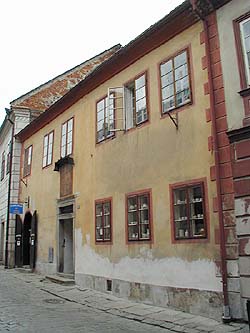Latrán No. 68
Description of the Building:
Two story building with plaster quoins on the sides and a painting
of the Madonna above the stone door lining.
Architectural and Historical Development:
This is a Gothic house that was modified during Renaissance. The
facade underwent a Baroque modification in the beginning of the
eighteenth century. The two story house has a plain facade with
plaster quoins on the sides. There is a painting of the Madonna
dated 1719 above the door with stone lining and a year of 1710.
Renaissance interior layout preserved on both floors, with barrel
vaults with caps and cross vaults. There is a ceiling with beams in
a part of the first floor with a carved guilloche on the downstand
beam.
 Significant Architectural
Features:
Significant Architectural
Features:
Painting of the Madonna dated 1719 above the entrance portal
(Virgin Mary Pomocná - Pasovská, restored in 1965). The painting
was commissioned by chancery-clerk to the prince Johann
Hammermilner (1679 - 1719) or by the following owner, Paul
Nader.
History of the House Residents:
The first owner recorded in writing was woman named Šimková Bílá in
the beginning of the sixteenth century. This is known because in
1525, Honta Paurnfeyt (probably Bauernvoit) sold "the house of
Šimková Bílá" to shoemaker Vaněk (Vácav). He sold it one year later
for only 86 three scores of Meissen groschen to shoemaker Ambrož
but purchased it back from him around 1535. He sold it again in
1537, this time to pewterer Jan. Jan died in 1543 however without
having paid for the house in full. Jan\'s wife lived in the house
during the 1540s, followed by stone-cutter Ambrož. The next owner
was "old pewterer Voršila from Latrán" who gave it in 1570 to her
son-in-law Adam Polák. He paid off the house in 1578 and died three
years later. After his death, widow
Markéta with her sons Řehoř and Michal lived here. In 1582, she
married fisherman Mates Dreyling who lived in the house until the
1590s. At the turn of the century, lackey Wolf lived here shortly
but was soon followed by maltsman Kašpar Langnitauf. In 1616, a
clerk dealing with orphans Tomáš Haklhőfer moved into the house and
owned it maybe up to 1654. Chancery-clerk Jan Hammermilner lived
here from 1679 to 1719. Many burghers of Český Krumlov of many
trades lived in the house after him.
After his death, widow
Markéta with her sons Řehoř and Michal lived here. In 1582, she
married fisherman Mates Dreyling who lived in the house until the
1590s. At the turn of the century, lackey Wolf lived here shortly
but was soon followed by maltsman Kašpar Langnitauf. In 1616, a
clerk dealing with orphans Tomáš Haklhőfer moved into the house and
owned it maybe up to 1654. Chancery-clerk Jan Hammermilner lived
here from 1679 to 1719. Many burghers of Český Krumlov of many
trades lived in the house after him.
Present Use:
Ceramics, betting shop Chance, Appartment


